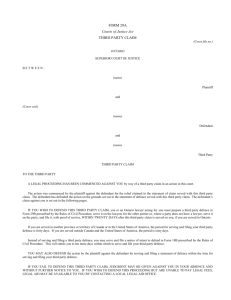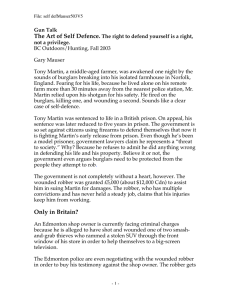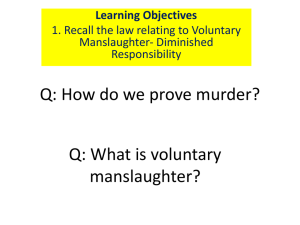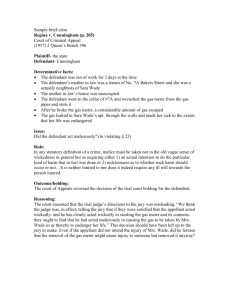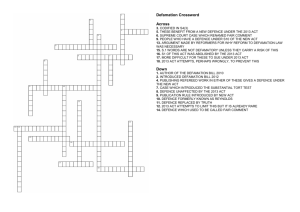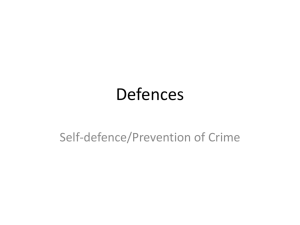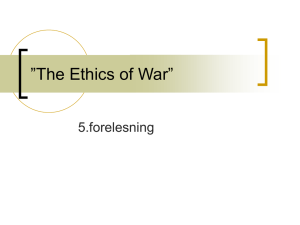Self Defence
advertisement
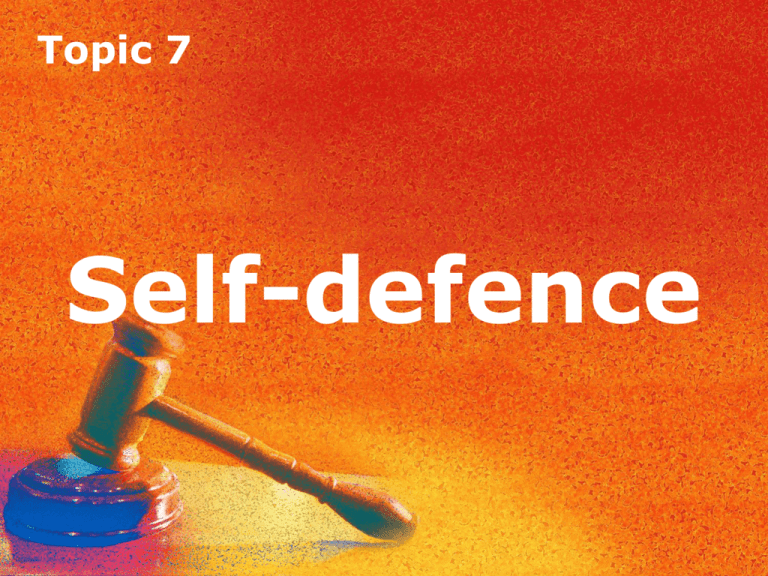
Topic 7 Topic 7 Self-defence Topic 7 Self-defence Introduction There are three situations where the use of force may be justified: Self-defence: this is a common-law defence, often termed ‘private defence’, which also includes defence of another person and defence of property. Defence of property: this area is regulated partially by common law and partially by statute, namely the Criminal Damage Act 1971. Prevention of crime: this is a public or statutory defence covered by the Criminal Law Act 1967, which states at s.3(1): ‘A person may use such force as is reasonable in the circumstances in the prevention of crime, or in effecting or assisting in the lawful arrest of offenders or suspected offenders or of persons unlawfully at large.’ Topic 7 Self-defence Elements (1) • For force to be justified, it must have been necessary. • The defendant is judged in the circumstances as he or she honestly believed them to be. • To decide whether force was necessary, the jury will consider the surrounding circumstances. • The force must also be reasonable – this is a matter for the jury in each case. Topic 7 Self-defence Elements (2) • Pre-emptive strikes are permissible, so a person does not have to wait to be attacked before defending himself or herself. • A defendant can use threats of force or threats of death in order to try to stop an attack on himself or herself, or to prevent a crime. • If the defendant believes that he or she is at risk of an attack on his or her person or property, he or she may be able to make preparations in order to defend himself or herself. Topic 7 Self-defence Elements (3) • A defendant is not under a duty to retreat. • If a defendant makes a mistake and thinks that selfdefence is necessary, he or she will be judged on the facts as he or she honestly believed them to be. This is still the case if the mistake was unreasonable. • If the defendant uses excessive force, the defence will fail. Topic 7 Self-defence Evaluation (1) The ‘all or nothing’ effect A situation may arise where some force is justified but the defendant uses too much. This means that the defence fails and critics have argued that this can lead to unfair results. For some offences, the need for some force can be taken into account when sentencing the defendant. In murder cases, however, the mandatory nature of the sentence means that this is not possible and the defendant will be convicted and sentenced to life imprisonment. Topic 7 Self-defence Evaluation (2) Intoxication The current rule is that a defendant will not be able to rely on a mistaken belief that self-defence is required if that mistake has been made due to intoxication. This has been criticised as being too harsh, particularly given that intoxication is a defence to specific intent crimes. Topic 7 Self-defence Reform (1) Allow an alternative conviction of manslaughter To combat criticism of the ‘all or nothing’ nature of the defence, it has been suggested that where some force is justified but the defendant uses too much and causes the death of the victim, it should be open to the jury to convict him or her of manslaughter rather than murder. This argument was rejected in Clegg, but the Law Commission, in its consultation document ‘Partial Defences to Murder’ (2003), suggested that this area needs to be re-examined. Topic 7 Self-defence Reform (2) Change the ruling in O’Grady The rule in O’Grady is seen by some as too harsh, and it has been suggested that mistakes as to the need for selfdefence induced by intoxication should operate as a defence.

